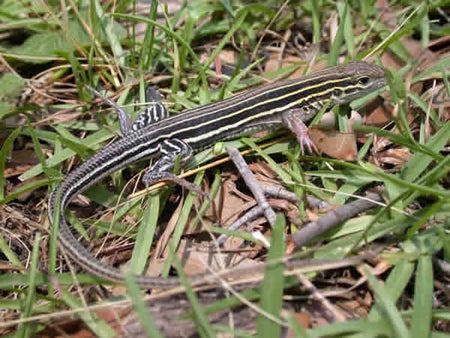SCIENTIFIC NAME:
Aspidoscelis sexlineatus sexlineatus
OTHER NAMES:
Six-lined racerunner, sand-streak
STATUS:
Uncommon to locally fairly common statewide. Most frequently encountered in southern portions of Alabama, but considerably less common than in the past. Decline could be related to decreased burning. Low Conservation Concern.
DESCRIPTION:
These fast-moving medium sized lizards range from 6-10 ½” as adults. They are rather vividly colored with six yellow to tan stripes running longitudinally down the dorsum, on a pale gray, olive, or black background color. Adult males usually have a blue belly from the lower jaw extending to the tail. Belly scales are very small, having the texture of velvet. Juveniles have the color and pattern of adults, but are usually 1 ¼” snout to vent length at hatching, with a blue tail.
DISTRIBUTION:
This is the only species of racerunner found east of the Mississippi River. They are found from Maryland south to Florida, extending west from Texas to Missouri. In Alabama, they are located statewide in suitable habitat.
HABITAT:
Six-lined racerunners inhabit well-drained upland sites, preferring loose soil or sand. They like open fields, natural openings, or disturbed areas that allow for sun-bathing and foraging for insects. They can often be found in cutover, highway right-of-ways, or early successional sites, and even rock outcrops.
FEEDING HABITS:
This species of lizard relies on sight to hunt small insects, arachnids, other reptiles, and occasionally, even mammals. They are voracious predators that hunt during day light hours.
LIFE HISTORY AND ECOLOGY:
Six-lined racerunners are adapted to very warm, dry conditions. They prefer to bask in daylight to obtain their optimal active temperature of 104°F. Once active, they begin feeding on insects and other small animals. They are very quick and agile escape artists and can quickly disappear into thick cover or small burrows. Females excavate small burrows in which to lay one to five white eggs, often laying two to three clutches per season. The female takes no special care of the eggs or young. They avoid seasonally cool weather and night time temperatures by burrowing into the ground or utilizing an existing mammal burrow.
REFERENCES:
Conant, Roger. 1975. A Field Guide to Reptiles and Amphibians of Eastern and Central North America. Houghton Mifflin Co., Boston, MA. 250 pp
Mount, Robert H. 1996. The Reptiles & Amphibians of Alabama. The University of Alabama Press. Tuscaloosa, AL. 171-172 pp.
AUTHOR:
Matt Brock, Wildlife Biologist, Division of Wildlife and Freshwater Fisheries






